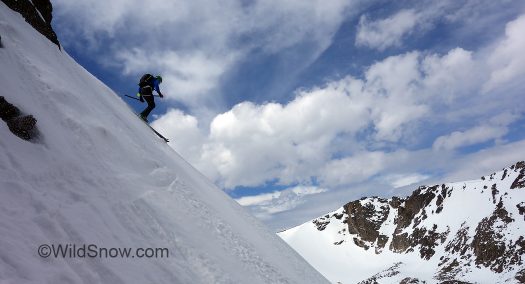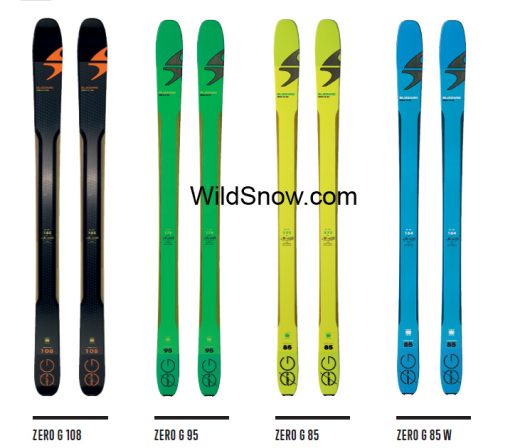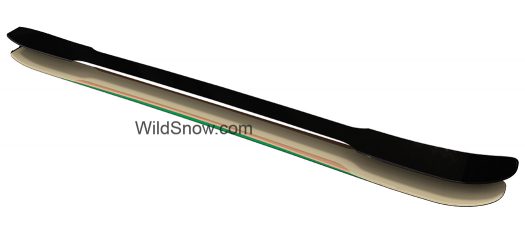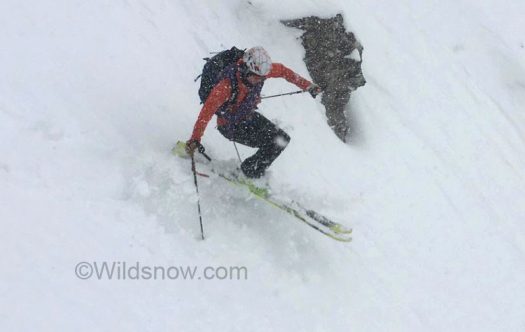
Patrick Cannon on Zero G this spring in Colorado. On the north face of Flattop, in Rocky Mountain National Park.
Consider the love interest who demands just a little more. Maybe not the easiest partner you’ll have in life, but in the end the effort is probably worth it. Ask for a little more, receive a little more…Blizzard’s Zero G skis do just that. These are not beginner, nor even intermediate, skis. The 85mm and 95mm-waisted ZeroGs require attention at times, especially outside their comfort zones. But as a result, they deliver.
(Naming convention note: It appears Blizzard spells it “Zero G” with a space. We mix in the contraction ZeroG here for convenience and reading flow.)
I’d heard so much good about Blizzard’s superlight boards, giving them a try was mandatory. The claimed weights (1176g/ski in the 85-waisted version in the 178cm length; 1247g for the 95mm 178cm) put them toe-to-toe with other brand’s lightweight offerings, but word on the street said they often charged better.
My question really became, which one? The 85 or the 95? I agonized over the two and in the end arrived a workable compromise. I’d own and ski both. (That might not exactly tie in with my “love interest” metaphor above…but I digress.)

The Zero G lineup. They may change the graphics but as far as we know they’ve not fixed anything that works, so shop with confidence.
Now I could ride both sets of skis and get a thorough understanding of each model’s strengths. Blizzard also makes a 108mm ski (1644g claimed weight in a 178cm), but my experience has been that skis of that width are entirely different tools, while the 85 and 95 skis are much more similar in function and application. When it comes to the ZeroGs, I have a hunch I’m correct in this, but I didn’t ride the 108s, so I’ll have to wait until next season for a take on those. Meanwhile.
Set-Up
I managed to get both Blizzards mounted with Dynafit Speed Radicals — one pair of the newest version (with the plastic tab that prevents rotation of the heel) and one with the last-gen (no internal pin, but ridges on the plastic mounting plate to prevent rotation). The skilled hands at Neptune Mountaineering, in Boulder, Colorado mounted all dead-center. The ZeroGs offer what they call a “rocker-camber-rocker” profile, which you can visually confirm in the shop as a small amount of early rise in the tip and tail, but nothing like the “surfy” shape touted with many other skis these days. The Blizzards ski their true length; you’re not losing anything to a dramatic early rise tip, nor a rockered tail. Put them base-to-base in the shop and you’ll see: if somebody didn’t tell me differently, I’d almost call these traditionally cambered over the length of the ski.
Construction
Blizzard touts its “Carbon Drive” guts as the foundation of the skis’ performance. The carbon component of the ski is a sheet across the ski’s width, with tiny sidewalls that drop to the edge. It resembles a cap, though the ski sports a traditional sidewall for much of its length. Think of the Carbon Drive as a “cage” surrounding a paulownia core. No metal to be found, save for the edges.

What Blizzard calls their ‘Carbon Frame’ is a specially shaped carbon layer in the construction. It works.
Carbon…the final frontier. Sure, but only if the engineers nail it. Carbon is infinitely “tune-able,” meaning its fibers offer strength in a single direction only, so depending upon the pattern and layup, the carbon can be progressive and smooth, torsionally rigid, impossibly stiff, chattery and harsh, or some devilish combination of the above. Getting it right isn’t easy.

Blizzard ZeroG construction. The Carbon Drive/FlipCore construction comes together with a 3/4-length sidewall and yields a very traditional looking ski.
Blizzard marries the carbon and paulownia, building their “Flip Core” technology — a system by which core of the ski isn’t flexed and manipulated into its camber/profile as much as it’s built and coaxed into that shape. The resulting core flexes more evenly, according to the Austrians. I’m willing to entertain the notion, as Blizzard’s ultra-successful freeride skis like the Cochise, Gunsmoke, and Scout have all relied on FlipCore for the past several years — to great acclaim. Indeed, the ZeroGs basically deliver that FlipCore and rocker-camber-rocker from the rest of the Blizzard line, albeit in tremendously leaned-out versions. Blizzard explains FlipCore and more on their website.
Testing
I got both pair of Zero G into my rotation at the end of the hateful, endless, high-pressure dry spell of our Colorado mid-winter. It was just as the climate guys predicted at the avalanche workshop in October: bountiful fall and early winter, followed by that persistent blocking high off the coast, and then a generous spring. Both models were wrung out on just about everything except resort groomers. I rushed to get this review written, but I regret not skiing these on some corduroy because I bet both ZeroGs would be delightful for resort fun. (Note, other WildSnow bloggers have indeed tested the ZeroGs on groom and verified that they do hook up fine.)
That said, the ZeroGs certainly weren’t crafted for corduroy, so I threw everything else at them. Let’s begin with the 95 (21.0m radius, 128mm and 111.5mm tip and tail, by the way). Mounted with the Speed Radical, they weighed 1659g/ski, home verified. I skied a monster, four-foot storm; guided a long day on them, including a 30-minute spell shoveling a skintrack for a nervous guest; scratched down a scoured, shady north face one afternoon; arc’d some GS turns in boot-top hotpow; and naturally tested their turnability with some wiggling in cold snow beneath towering Douglas firs.
As Blizzard promises, the ZeroGs deliver tenacious edge-grip. I’ll credit the torsional stability from the carbon cage, as well as the sidewall construction. The 95 (as well as the 85) feels like a traditional, European-made sidewall ski. Stable, firm, and I found the edge-hold trustworthy. I found the ski reliable, predictable, and without the penalty a rockered ski gives in terms of running length. Lay the 95 over on firm snow and you feel the tip-to-tail edge — good! (As with any torsionally rigid somewhat traditionally cambered ski, how you de-tune the tips and tails of ZeroG is critical. If they feel “hookey” at either tip or tail, time to bring out the stone.)
Early April brought a powerful closed-low through the Four Corners, dumping a good dose of snow throughout the mountains and with a happy wrap-around blast of upslope to the Colorado Front Range to cap it off. Though I’d probably opt for the 108 Blizzard in that situation, I took the 95 out, intentionally pushing it out of its comfort zone. We had 120cm of medium-density snow on the ground. The 95s were going to have to do.

Soft day in Rocky Mountain National Park’s Dragontail Couloir, sliding on the ZeroG 85. Probably would’ve been happier on the 95, but good test beta nonetheless.
A “surfier” tip would certainly have been a more relaxing ride, but the Zero G 95s were capable. Were they perfect? No, but I could link round, energetic turns on them by staying centered and not driving the tips too hard. Without 20-or-more centimeters of early rise, I couldn’t gun the 95s into wanna-be Seth turns, but if I stayed centered, focused on unweighting and initiating the next turn, they made it happen.
Now, all this requires a willing partner. I can’t say I’d suggest the Zero G 95 to a less experienced skier. I think they’d have trouble keeping them from diving in deeper snow and the lack of significant rocker makes them less forgiving in chop. The carbon-paulownia core, too, requires some attention not to get bucked. There it is. The ZeroGs are not beginner skis.
That said, if I had to own a single pair of skis right now, this might be it. Almost no compromise in a couloir, light enough to go huge in Canada for a week, handles just about every Colorado storm I’ll encounter, maybe a little demanding, but hey…they deliver.
The ZeroG 85
My last couloir ski was Chinese made, skied shorter than its 176cm length (I’m 5’10”, 165 lbs.), I warrantied it twice … so you get it, not a match made in heaven. I used my Cho Oyus a bit on the steeps, but man, as I said, no confidence when overloaded. I was psyched to get on a less-rockered ski with more umphf, traditional sidewalls, and see what all the hype was about.
I tried to outsmart the 85s, too, by riding them in deeper snow (19.0m radius, 116mm and 99.5mm tip and tail). Nothing extreme, but shin-deep untracked on a supportable crust. Just as I’d have probably skied the 108s on my four-foot day, I should’ve taken the 95s out that particular day (on South Hayden, above Ashcroft), but the 85s were a gas. Light snow and a supportable crust made bigger hero turns as possibility and I was smiling at the unexpected willingness of the 85 to ski fast and in soft snow. Total hoot.
Now, in their element, I’m not sure I’ve skied a better mountaineering, couloir, traverse ski. The 85 is light, as in double-take light. Your first day on the up and you’ll be shocked if you haven’t skied one of the truly superlight skis out there. Schlepping the skis on your back, too, is a joy. I typically prefer to A-frame, just to keep the weight closer to my body, but step out of the 85s and mount them on your pack and none of the tiring, annoying swing weight of having heavy boards far from your center of gravity.
The light weight, though, would be for naught if they underperformed on the down. The 85s are balanced, stable, and predictable on hammered boilerplate, so imagine what they do with a few millimeters of edge-penetration. Corn? Forget the 19m turn radius, open them up! The non-existent swing weight means they maneuver capably in tight quarters. They’re simply an awesome couloir-steeps ski.
The other place I think the light weight matters is in breakable crust and grabby conditions. Why? The key, for me at least, in skiing unforgiving conditions like these is redistributing one’s weight more evenly—let’s say 65/35, rather than a more traditional 90/10 downhill/uphill distribution. By skiing both skis more evenly, if one dives or hangs up, you can recover momentarily on the other (usually uphill) ski. You’re less likely to irretrievably submarine your downhill ski, too, if you can quickly unweight it, reset, and keep skiing. A superlight ski helps do this.
So…Which One?
Good question. Having logged several days on each and in varying conditions, if I had to own one, I’d go with the 95 Zero G. Quit laughing yet? Yeah, of course, who owns one ski? If I could own two, I’d probably get the 85 and the 108 — provided the 108 is as worthy a ride as the other two. Why? The 85 does what it does exceptionally well, performing on firm snow, steeps, and even variable conditions, as well as dropping a ton of weight. I’d rather harness all that performance and enjoy soft snow on the 108, “lugging” a couple hundred extra grams in place of the 95.
This is 2016, though, and I love skiing. Let us not kid ourselves, by next January I’ll have a set of 108s, too.
Keep in Mind
If there is a down side to the ZeroGs, it has to be forgiveness. I wouldn’t call either ski stiff in a global sense, but compared to a lot of the more forgiving lightweight touring skis out there, the 85 and 95 ZeroGs trend towards stiffer. Couple that with the much more traditional camber and they’re more demanding. This is less a gripe than an acknowledgment of a design decision by the Blizzard folks, but skiers shouldn’t expect an autopilot-ride in variable chop and demanding conditions on either ZeroG I’ve reviewed here. Put another way: An inexperienced skier will find happier times with a more forgiving shape/profile.
Your Comments
I’d love to hear what the WildSnow crew thinks, especially for those of you who’ve skied planks in similar weight class that perform. Fire away and in the meantime, enjoy your spring skimo season. We’re still riding out the remnants of an El Nino winter and I, for one, am psyched!
(Note: Pre-cut Pomoca skins available for all three ZeroG skis. Blizzard is also offering a rando ski with a 65mm waist with a claimed weight of 675-685g, paulownia/Isocore core.)
Shop for Blizzard Zero G skis.
(Rob Coppolillo is an IFMGA/AMGA mountain guide and the co-owner of Vetta Mountain Guides. His next book, The Mountain Guide’s Manual, is due out by FalconGuides in March, 2017.)
Rob Coppolillo is a mountain guide and writer, based on Vashon Island, in Puget Sound. He’s the author of The Ski Guide Manual.
